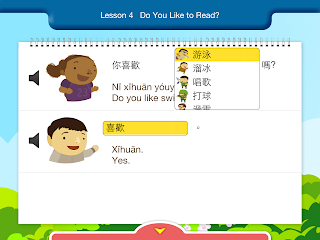

Sometime near the beginning of the school year I discovered that the company that produces Chinese Wonderland, the textbook the children used in Level 1 Mandarin, makes apps for use on the iPhone and iPad. I purchased Level 1, traditional Chinese, and used it sporadically with Cilla throughout the year. It follows the same curriculum as the textbook and offers supplementary practice with the same vocabulary and structures (so there's nothing really new here, though the dialogues are somewhat different from those presented in the textbook). It's fairly well-done, but we didn't use it often, mostly because there wasn't much to do with each chapter (You can finish a chapter in 5 minutes), and so, with an already busy schedule and other Chinese homework to complete, we simply fell out of the habit of doing it.

This week, however, I've revisited it and I now see it as a nice tool for reviewing during the summer so that we do not lose all the progress we've gained. What I like is that it's the same stuff the children have learned but in a format they haven't yet seen, so it seems fresh. I also like that the vocabulary is presented in a sentence and you can make substitutions with other vocabulary in the sentence (You can change one of the words in the sentence and hear it read to you). I thought the textbook could have done a better job of encouraging the children to make new sentences by inserting different vocabulary into basic sentence structures, so it was nice to see this feature on the app.
Other notes and tips:

This week, however, I've revisited it and I now see it as a nice tool for reviewing during the summer so that we do not lose all the progress we've gained. What I like is that it's the same stuff the children have learned but in a format they haven't yet seen, so it seems fresh. I also like that the vocabulary is presented in a sentence and you can make substitutions with other vocabulary in the sentence (You can change one of the words in the sentence and hear it read to you). I thought the textbook could have done a better job of encouraging the children to make new sentences by inserting different vocabulary into basic sentence structures, so it was nice to see this feature on the app.
Other notes and tips:
- I bought the app for $2.99, but as with many apps, the price can fluctuate. I have since seen it for $.99.
- Encourage your learner to sometimes try to read aloud the words and sentences before listening to them. After listening, say the word or sentence again for more pronunciation practice.
- The app allows you to see characters, pinyin, and English together. Although this can certainly be helpful at times, it is important for the children to be able to read the Chinese characters without seeing the pinyin and to be able to understand the meaning without seeing the English. It would be nice if there were a way to hide the pinyin, English, and characters, but there doesn't seem to be. In some places, you can scroll down slowly so as not to reveal the pinyin or Engish translation until you're ready; in other places, hiding this info is more difficult.
- Encourage your student to read the Chinese characters first whenever possible. If she doesn't know the sound the character makes, then have her look at the pinyin and read that if she is able. Likewise, avoid looking at the English translation unless your child really does not know what something means. Requiring an English translation at every turn can sometimes impede the flow of the Chinese ( and it really isn't as necessary as we are trained to think it is) , so sometimes let things go without asking for one.
- You can certainly let your little learner loose to do the app on her own, but there are certain benefits to sitting down to do it with her from time to time. That way you can make sure she gets the maximum benefit from it.
No comments:
Post a Comment